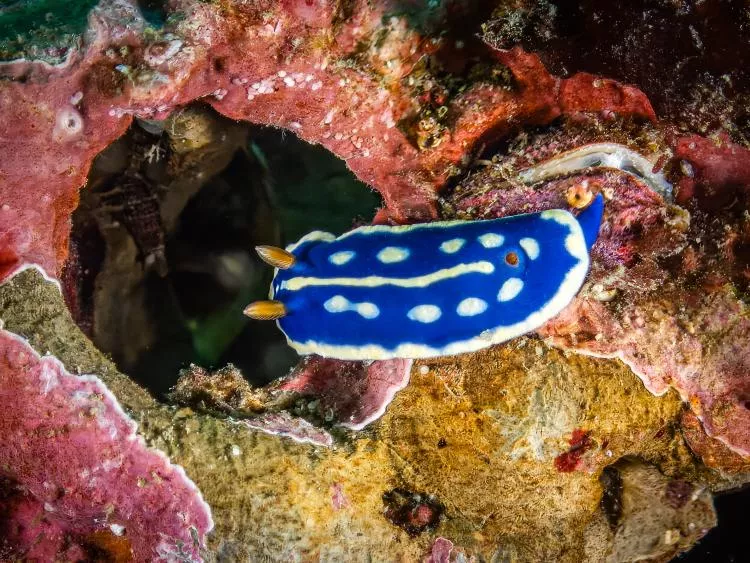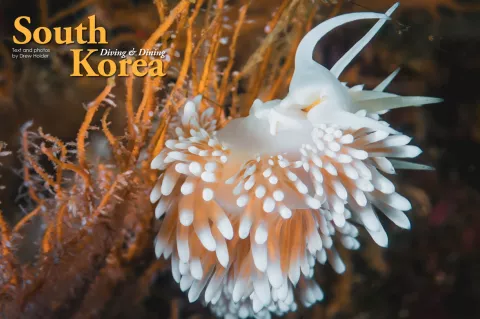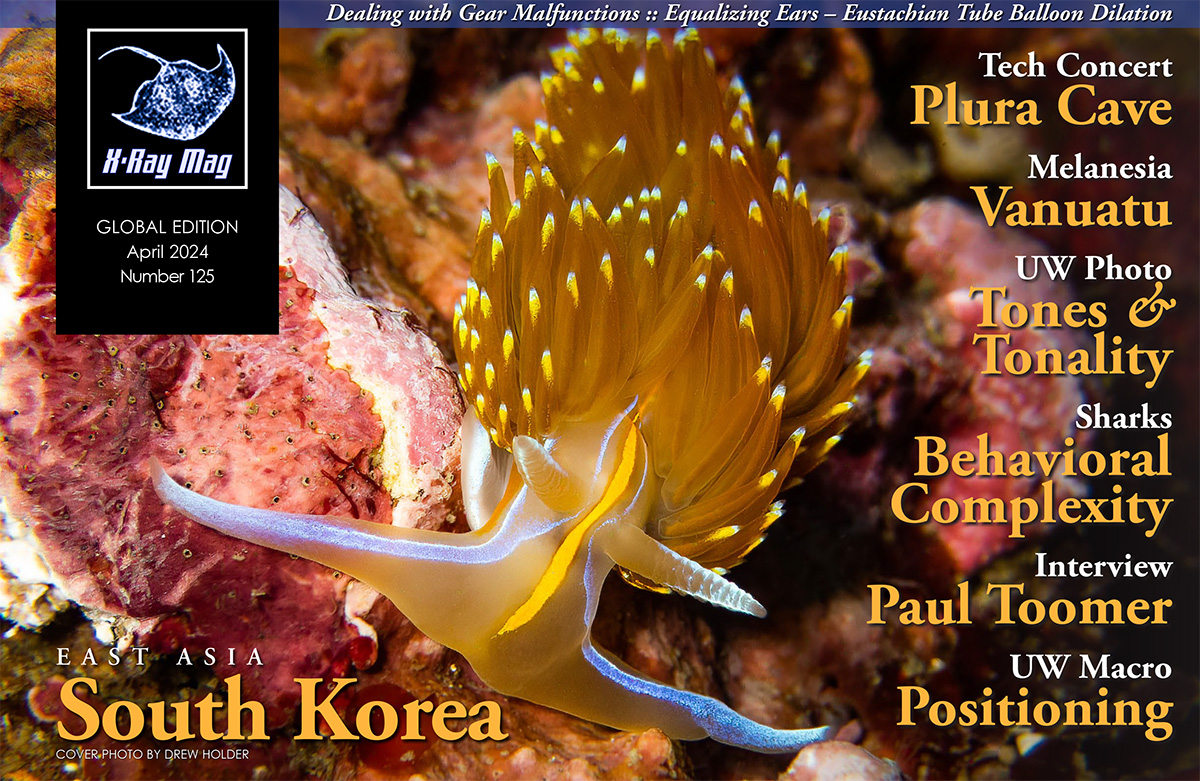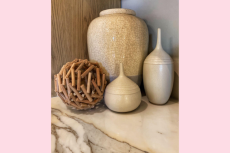South Korea has a lot to offer underwater photographers, recreational divers, and technical divers, from wall dives and artificial reefs to a variety of marine life and a wide array of nudibranchs, not to mention topside attractions to enjoy between dives, from beautiful nature parks and scenic trails to cultural events and fine dining. Drew Holder gives us an inside look.
Contributed by
South Korea has been a hidden gem of a dive destination for both my 11-year-old son and me. After living in South Korea for almost two years, we have had the opportunity to explore several areas from Yangyang on the northeast coast down to Jeju Island in the south of the peninsula.
Much of the east coast down to the south coast is rocky coastline with cliffs in many areas. There are several sandy beach areas on the eastern and southern coasts that can facilitate shore diving, but most diving is done by boat. The western coast of South Korea has shallower waters with tidal mudflats that do not offer as many diving opportunities. Below are five locations around South Korea and photos of some of the biodiversity that I have seen along the way.
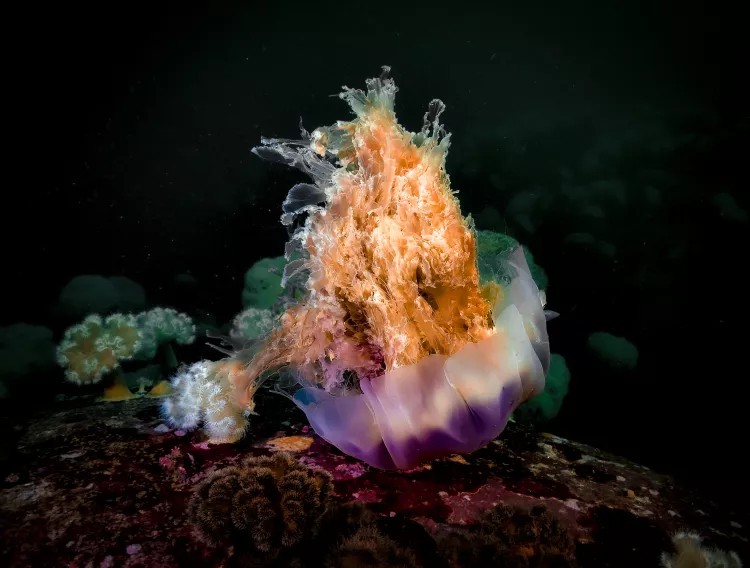
Yangyang. Located on the East Sea, also known as the Sea of Japan, this area offers deeper waters closer to shore. My experience in this area was in November with water temperatures of 52°F (11°C) at a depth of 90ft (~27m). Marine life in this area includes jellyfish, plumose anemones, and several species of pufferfish.
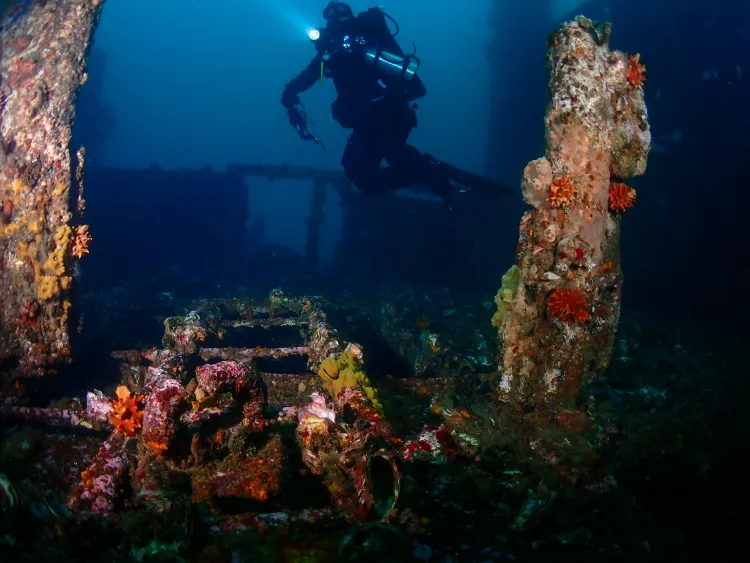
Gangneung. This area is the home to the Stella wreck, a fishing trawler that was sunk as an artificial reef and tourist attraction. The wreck lies in about 100ft (~30m) of water and is frequented by moderate to strong currents. Other artificial reefs such as armored personnel carriers and various types of military equipment can be found in the area.
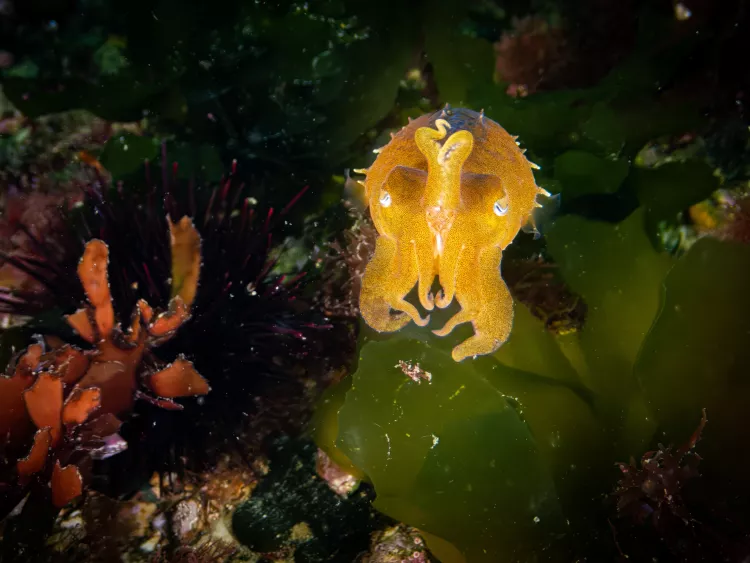
Pohang. This location became my most frequented area to dive as it was only an hour’s drive from where I lived. This area boasts a variety of life with patches of cold-water corals, many different types of nudibranchs, skates, octopus, and even cuttlefish. Farther offshore, the bottom is composed of some sandy areas that are sandwiched between massive boulders. Some areas have small canyons that look like riverbeds and are unique to swim through. Closer to the shore, there is a large, sheltered harbor that receives less surge, allowing the underwater plant life to thrive. In this kelp habitat, there are many sea hares ranging in size from tennis balls to basketballs.
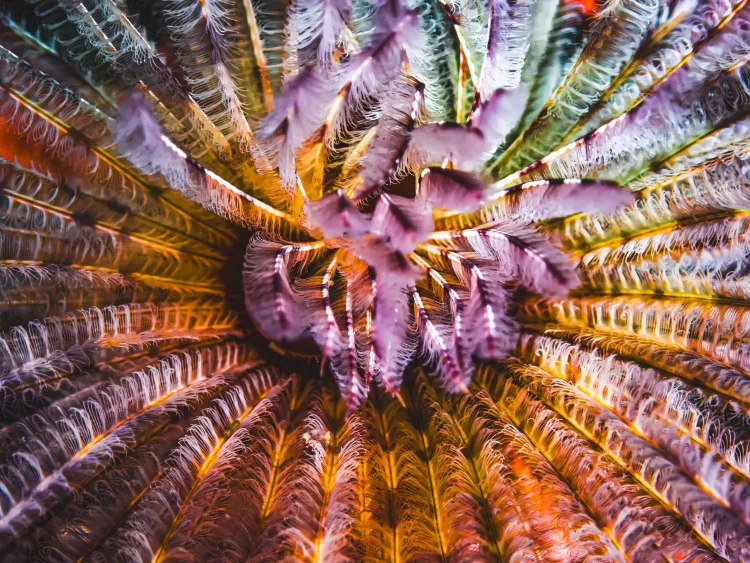
Tongyeong. Unlike Yangyang, Gangneung, and Pohang, Tongyeong is in the South Sea. The land features of this area have a multitude of small peninsulas and islands scattered along the southern coast. The dive operator that I used would take divers by boat an hour south, past most of the commercial fishing areas, out to remote islands. The boat would then drop divers off around these small islands for a wall dive type of experience. Here you will find more tropical species of fish, anemones, lionfish, crinoids, and nudibranchs.
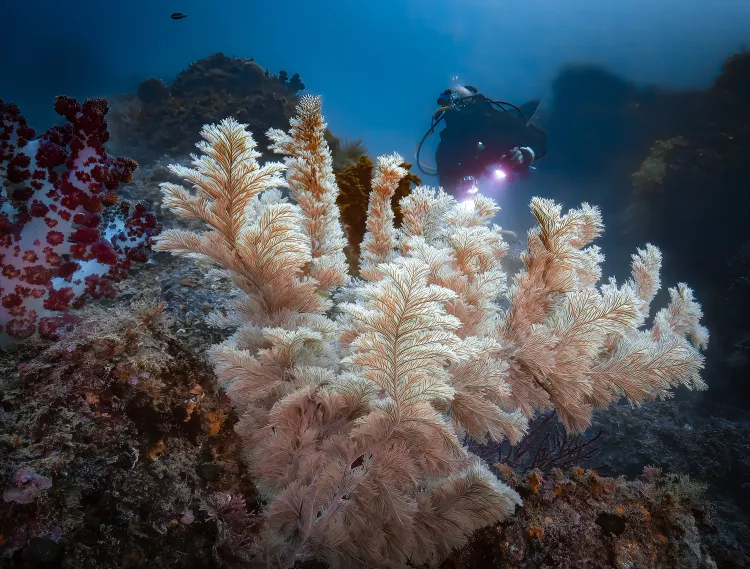
Jeju Island. I only had one opportunity to experience diving in Jeju and it was great! Most people fly to Jeju Island, which is south of the Korean peninsula, but I took my family by ferry from Mokpo, on the southwestern coast, and it was far superior to traveling there by air. The four-hour ferry ride was relaxing and felt more like a cruise ship than a ferry. The ferry allows you to take your rental or personal vehicle, and there are restaurants and plenty of activities to do on board.
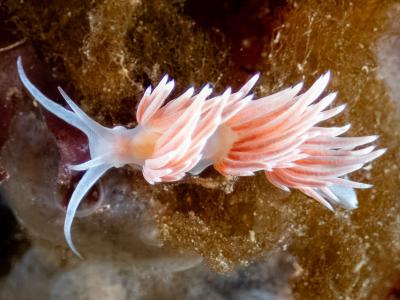
Once on the island, we traveled to the south side as most of the dive centers are in Seogwipo. I did three dives on my trip, the first two had excellent visibility and amazing soft corals everywhere. For the third dive, I asked the guide if there were any shipwrecks in the area. He said, “Yes, but it will be a difficult dive.”
This third dive was amazing, even though the visibility was less than ideal. On this dive, the current was strong, the depth was 130ft (~39m), and there was a tourist submarine lurking in the background behind the haze of the water. However, the wreck itself was full of life, covered with thousands of soft corals and tropical fish.
Nudibranchs!
Every dive site I visited in South Korea had nudibranchs. After hundreds of dives in tropical areas of the Pacific, it was always a rare treat to see a nudibranch. It is a different story in the waters of South Korea—the nudibranchs are everywhere! The pictures I present here are just a few of what can be seen, but there are many more out there.
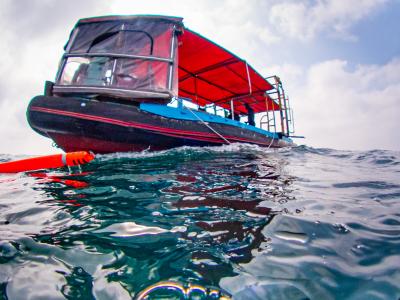
Korean style dive boats
The main feature that most dive boats in South Korea have in common (and is the most convenient) is the use of an elevator system instead of ladders to get back on the boat after the dive. These systems use a winch mounted on the top of an elevator that lifts a platform out of the water, carrying one or two divers at a time. Entry into the water, however, remains the standard means, with either a back roll or a giant stride.
Topside excursions
After almost two years of traveling in South Korea, it is difficult to pick my favorite sites from the many places my family and I have explored. Here are a few places that were exceptional.
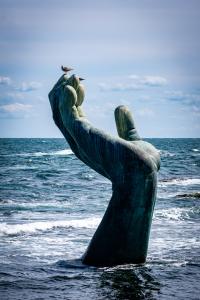
Homigot Sunrise Square, located in Pohang, in the easternmost part of the country, is famous for its sculpture of a hand reaching out from the ocean (note the seagull in the photo for scale). As the most easterly point in South Korea, it receives the first sunrise each day. If you arrive early enough, you can photograph the sun and the sculpture in the same frame.
Jeju Island has a milder climate than the Korean peninsula and feels much more subtropical. The island has many attractions, with my personal favorite being the geological and volcanic features. There are areas along the coastline where you can see different layers of volcanic ash deposits that span thousands of years, revealed by water erosion. You can also find columnar basalt, a hexagonal lava rock formation created when lava comes in contact with water.
Biseul Mountain Recreational Forest. Located about an hour’s drive inland, just outside the city of Daegu, this place is a great attraction to see in winter. An ice hill festival is held here annually, for which an ice formation is “grown.” It can be seen while hiking in the forest. The hazy forest with ancient temples along the path is a must see.
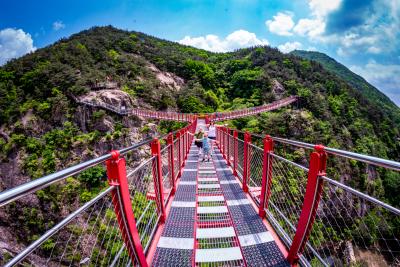
Gayasan National Park. If you are looking for some crazy scenic views from a three-way suspension bridge, look no further than the Udusan Chulreong bridge in Gayasan National Park. The park is located just west of Daegu. It takes about 30 minutes to hike up a winding staircase to the top of the mountain, which leads to the wobbly bridge—for those who are not afraid of heights.
Apsan Mountain. Finally, a view from the top of Apsan Mountain, located in Daegu Apsan Park, south of the city. There is an intriguing directional sign here, showing where South Korea sits amongst the rest of the world.
Cuisine
When my family and I moved to South Korea, we really did not know what to expect when it came to food options, but lucky for us, we were in for many delicious treats. We were pleasantly surprised to discover that you did not have to go far in the cities to find a café, a bakery, or just about any genre of restaurant.
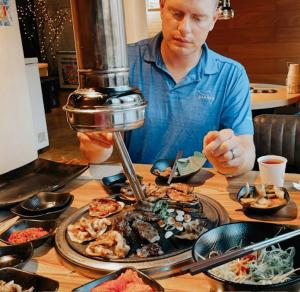
Not only have we come to appreciate the taste of the food, but we have been consistently blown away by the level of detail, craftsmanship, and pride that the chefs put into their creations. South Korea has certainly spoiled our taste buds.
As of early 2024, there are now over 200 Michelin-recognized restaurants in the country, including 36 Michelin-starred restaurants and 72 Bib Gourmand (good, yet moderately priced) establishments in the capital city of Seoul, as well as in Busan on the southeastern coast (– Ed).
Final thoughts
South Korea never seemed like a bucket list dive destination to me, initially, but I have come to appreciate its beauty after seeing it first-hand. It may not be for the tropical, warm water enthusiast. However, if you want to see unique things and experience a new culture by taking the road less traveled, then go dive in South Korea! ■
Special thanks go to Yellow Submarine Dive Center in Daegu. Course director, Mr. Lee (aka Red), has helped US and international divers for many years, offering PADI training and guided tours of the East Sea of Korea. Visit: yellowsubmarinedive.modoo.at (for English, use your browser’s translation tool).
Drew Holder is an American underwater photographer based in Daegu, South Korea. Visit: Instagram.com/h20_life_below
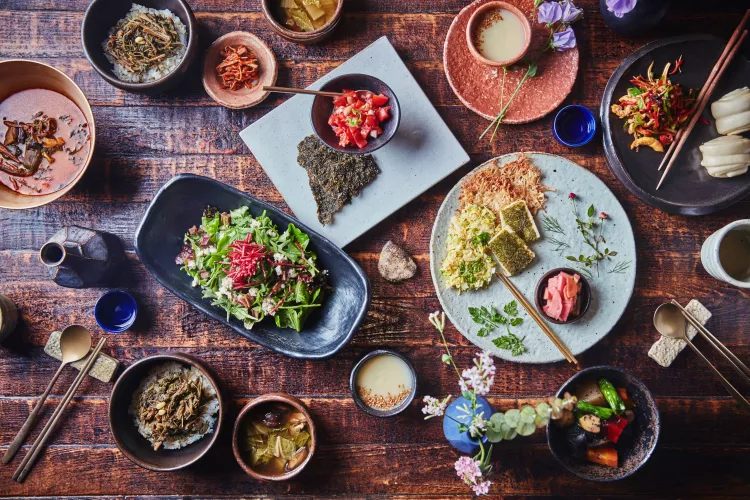
Topside Fare: Fine Dining in Seoul & Busan
Text edited by G. Symes
In South Korea, there is plenty to enjoy between dives when it comes to fine dining. There are 36 restaurants in the country that have been awarded Michelin stars, one of the highest honors a restaurant can receive.
While 33 are located in Seoul, three are in Busan on the country's southeastern coast. After diving in the northeast at Yangyang and Gangneung, why not make a stop in Busan for some fine dining on your way south to dive at Tongyeong and Jeju Island?
Bib Gourmand. There are also 15 restaurants in Busan and 57 restaurants in Seoul that have received the Bib Gourmand award for quality cuisine at moderate prices. So, you do not have to break the bank to eat well.
Green Star. For eco-conscious diners, there are three restaurants that have received the Green Star, which recognizes sustainable practices that meet both ethical and environmental standards: the Michelin-starred Fiotto in Busan, and Gigas and A Flower Blossom on the Rice in Seoul.
Food tasting tours. There are also a number of food tours to enjoy in cities across the country, including tours of local food markets, street food stalls, little known cafés, and tours led by local chefs. Explore a taste of Busan or a foodie tour in Seoul. ■
For more information, see the Michelin Guide at guide.michelin.com or the K-Food Tour Guide.
Sources: Michelin Guide, Korea Tourism Organization

